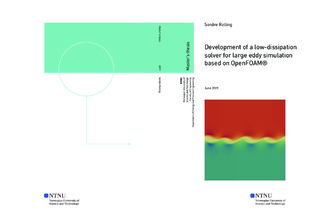Development of a low-dissipation solver for large eddy simulation based on OpenFOAM®
Abstract
Det er en absolutt nødvendighet ̊a ha nøyaktige resultater innenfor numeriskfluidmekanikk(CFD). Dette har vært en utfordring helt siden industrien toknytte av dette verktøyet p ̊a 60-tallet. P ̊a grunn av de komplekse og krevendekalkulasjonene, fikk CFD en oppsving p ̊a 90-tallet i lag med prosessorenesom stadig kunne takle flere kalkulasjoner per sekund. Industrien kunnedermed redusere antall eksperiment og potensiale ligger i ̊a videreføre denneutviklingen.For ̊a kunne videreføre denne trenden, er det to ting som st ̊ar sentralt.Den første er at det trengs kunnskap om CFD og teorien bak, alts ̊a i hovedsakfluidmekanikk og numerikk. Derfor er teorien brukt i denne masteroppgavenpresentert. I tillegg er to sentrale numeriske metoder presentert. En kortoppsummering av stegene til ”pisoFoam” er ogs ̊a inkludert. Dette er enstandard ”solver” i OpenFOAM®, alts ̊a en algoritme laget for ̊a løse NavierStokes ligningene. Det har blitt gjennomført flere tester av denne algoritmenfor ̊a danne et sammenligningsgrunnlag.Det andre er at nøyaktige algoritmer burde være lettere tilgjengelig,slik at resultatene er mer reelle og troverdige. Rekonstruering av en algor-time fra artikkelen: ”On the implementation of low-dissipative RungeKuttaprojection methods for time dependent flows using OpenFOAM®” er derforgjennomført i denne oppgaven. Dette er en eksplisitt algortime, med Runge-Kutta metoden som tidsintegrasjon. Prosedyren og koden for ̊a gjøre detteer presentert i denne masteren, sammen med en verifisering der den blirsammenlignet med tidligere resultater og ”pisoFoam”. I ”lid driven cavity”viste den samme resultater som tidligere arbeid og ”pisoFoam”. En un-dersøkelse av bevaring av energi ble testet i ”Taylor Green Vortex”. I denneoppgaven ble viskositeten satt til null, derfor burde det ikke være noe tap avenergi. Den nye algortimen bevarte betydelig mer energi enn ”pisoFoam”,som bekrefter en mer nøyaktig algoritme. I ”temporal mixing layer” klarteden nye algoritmen blant annet ̊a følge den anerkjente 5/3-loven og haddekjente turbulente strukturer, som viser at den ogs ̊a kan simulere turbulentestrømninger A necessity in computational fluid dynamics (CFD) is to provide accurateresults at a reasonable cost. This has been a challenge since the industrystarted utilizing the engineering tool in 1960’s [1]. Due to its complexity, itrequires strong computational power. Therefore, it gained popularity alongwith the growth of computer power during the 90’s and until today. TheIndustry started to take advantage of this tool, replacing expensive experi-ments and facilities, and the potential is to keep extending this trend.In order to make that happen, two main things are needed. First abroader knowledge of CFD and the concepts behind it are essential. There-fore, this thesis covers some of the fundamental theory of numerics and fluidmechanics, including a brief study of the OpenFOAM®solver ”pisoFoam”,which is an iterative transient incompressible solver based on the SIMPLE-algorithm. The application of it is tested in several cases.Secondly, more low-dissipative methods need to become more commonlyavailable, providing accurate and beneficial results. The theory presented isused to reconstruct the solver in the article: ”On the implementation of low-dissipative RungeKutta projection methods for time dependent flows usingOpenFOAM®” and implementing it into OpenFOAM®[2].This is a solverwith the projection method, and Runge-Kutta method in time. The proce-dure is presented in this thesis. Verification and a comparison between theresults from the article showed that the ”pisoFoam” solver and the resultsfrom the newly constructed solver were a close match in the lid driven cav-ity, and therefore strengthens the credibility of the newly constructed solver.Also, a numerical dissipation of energy test was conducted, confirming thatthe Runge-Kutta projection method had significantly less numerical dissi-pation. In the temporal mixing layer case, the projection method was ableto capture the energy characteristics, such as the 5/3 law, vortex structures,confirming it models the turbulence well.
